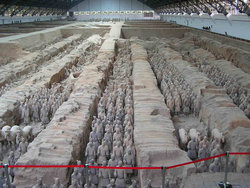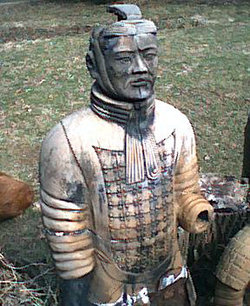Terracotta Army
|
|
XianCavalryman.JPG
Terracotta_army_xian_embedded_warrior.jpg
Terracotta_army_xian_assembling_warriors.jpg
The Terracotta Army (兵馬俑; pinyin: bīng mǎ yōng, literal meaning: "Soldier and Horse Figures"), inside the Mausoleum of the First Qin Emperor (秦始皇陵; pinyin: qín shǐ huáng líng), was discovered in March 1974 during the sinking of wells for farmland irrigation construction near Xi'an, Shaanxi province, People's Republic of China.
Professional excavation of the vaults started soon thereafter.
The army consists of more than 7,000 life-size tomb terra cotta figures of warriors and horses buried with the self-proclaimed first Emperor of Qin (Qin Shi Huang) in 210-209 BC.
With their burial it was believed that the Emperor would still have troops at his command. The Terracotta Army was buried in battle formation in many vaults, 1.5 kilometres east of the tomb of the Emperor, which is 33km east of Xi'an. Three vaults, measuring about 4-8 metres deep, have been excavated and a museum set up on the ruins, called Xi'an First Qin Emperor's Terracotta Army Museum (西安秦始皇兵馬俑博物館). Vault One was opened to the public in 1979, and the whole museum was completed in 1994.
The figures were painted before being placed into the vault. The original colors were visible when the pieces were first unearthed. However exposure to air caused the pigments to fade so today the unearthed figures appear terracotta in color.
The figures are in several poses including standing infantry and kneeling archers as well as charioteers with horses. Each figure's head appears to be unique showing a variety of facial features and expressions as well as hair styles.
Bronze chariots
In 1980 two painted bronze chariots were discovered 20 metres west of the tomb of the Emperor. Consisting of 3000 parts, each of the chariots is driven by an imperial charioteer and drawn by 4 horses. According to the Han Dynasty scholar Cai Yong (蔡邕 132-192), the first chariot was for clearing the road for the Emperor's entourage, and the second was his sleeping chariot. The bridles and saddles of the horses are inlaid with gold and silver designs and the body of the number 2 chariot has its sliding windows hollow cut. Both are half life size and are now displayed in the Museum.
In 1987, UNESCO added the Terracotta Army and the Tomb of the First Qin Emperor to the list of the World Heritage Sites.
See also
External link
- Emperor Qin's Terra-cotta Museum (http://www.bmy.com.cn/)de:Terrakottaarmee
es:Ejército de terracota he:צבא הטרקוטה hr:Vojska terakota ja:兵馬俑 pl:Terakotowa Armia zh:秦始皇兵马俑


